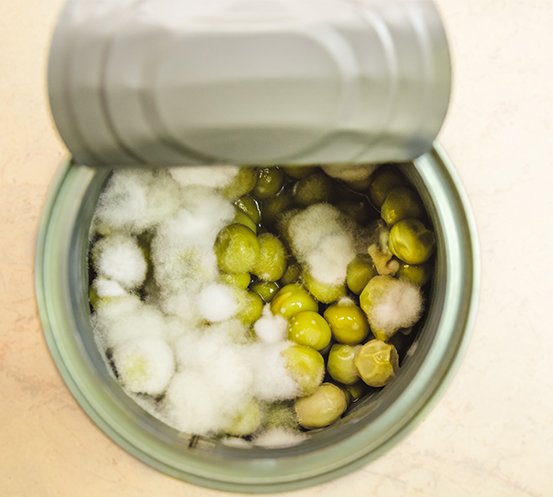ถอดบทเรียน: อันตรายจากเชื้อจุลินทรีย์ที่ปนเปื้อนในผลิตภัณฑ์อาหาร Lessons Learned: The Dangers of Microbial Contamination in Food Products
592 Views |

By: ผศ. ดร. สุคันธา โอศิริพันธุ์
Assist. Prof. Sukhuntha Osiriphun, Ph.D.
Department of Food Science and Technology
Faculty of Agro-Industry
Chiang Mai University
sukhuntha.o@cmu.ac.th
ถอดบทเรียนที่ 1: สิ่งแปลกปลอมสีขาวกระจายทั่วไปในอาหารกระป๋อง
Q: ผู้บริโภคร้องเรียนว่า พบสิ่งแปลกปลอมสีขาวกระจายทั่วไปในอาหารกระป๋อง มีลักษณะคล้ายพยาธิ หนอนมีชีวิต หรือเชื้อรา จึงขอทราบสาเหตุที่แน่ชัด รวมถึงแนวทางการป้องกันและแก้ไขปัญหาที่เกิดขึ้น
A: การพบสิ่งแปลกปลอมคล้ายพยาธิ หนอน และราในอาหารกระป๋อง ถือเป็นเรื่องที่น่ากังวลอย่างยิ่ง บ่งชี้ได้ว่า มีการปนเปื้อนของสิ่งแปลกปลอมเหล่านั้นในระหว่างกระบวนการผลิตอาหาร เช่น การปิดฝาที่ไม่เหมาะสม และเกิดข้อบกพร่องในการควบคุมด้านสุขลักษณะในโรงงาน จึงสันนิษฐานได้ว่าอาจเกิดจากสิ่งแปลกปลอม เช่น
1. ตัวอ่อนแมลง: สันนิษฐานว่าเกิดจากแมลงบางชนิด เช่น แมลงปีกแข็งหรือแมลงวันที่วางไข่ในอาหารกระป๋องที่ปิดไม่สนิท ทำให้ไข่ฟักเป็นตัวอ่อนได้
2. ไส้เดือนฝอย: สันนิษฐานว่ามาจากแหล่งวัตถุดิบอาหารต่างๆ แต่ไส้เดือนฝอยมีขนาดที่เล็กมากจึงตรวจสอบด้วยสายตาได้ยาก หากตรวจสอบต้องใช้อุปกรณ์พิเศษ เช่น กล้องซูมสเตอริโอ เป็นต้น
3. รา: สันนิษฐานว่าอาหารกระป๋องเกิดการปนเปื้อนจากสปอร์เชื้อราในระหว่างกระบวนการผลิตหรือบรรจุ และพัฒนาเป็นโคโลนีเชื้อราที่ปรากฏเป็นสีขาวหรือสีอ่อนได้
การบริโภคอาหารที่ปนเปื้อนปรสิต หนอน ราหรือสิ่งแปลกปลอมอาจนำไปสู่ความเสี่ยงต่อปัญหาสุขภาพที่เกี่ยวกับระบบทางเดินอาหาร เช่น คลื่นไส้ อาเจียน ท้องเสีย หรือภาวะแทรกซ้อนที่รุนแรงขึ้น ทั้งนี้ขึ้นอยู่กับชนิดและปริมาณเหลือรอดของจุลินทรีย์เหล่านั้น โดยผู้บริโภคควรหลีกเลี่ยงการบริโภคอาหารดังกล่าวและหากเกิดอาการไม่พึงประสงค์หลังจากการบริโภค ให้รีบพบแพทย์โดยเร็วที่สุด ผู้บริโภคควรพิจารณาเลือกซื้ออาหารกระป๋องที่มีคุณภาพ โดยพิจารณาจากหลักปฏิบัติ ดังนี้
1. เลือกซื้ออาหารกระป๋องจากผู้ผลิตที่เชื่อถือได้ โดยพิจารณาจากเครื่องหมายทางการค้า สัญลักษณ์คุณภาพและมาตรฐานการผลิตที่ผ่านการรับรองจากหน่วยงานของภาครัฐ
2. ตรวจสอบลักษณะกระป๋องว่าไม่พบรอยบุบ รอยนูน หรือร่องรอยความเสียหายอื่นๆ ที่อาจส่งผลกระทบต่อคุณภาพและความปลอดภัยของอาหารกระป๋อง
3. ตรวจสอบวันหมดอายุและหลีกเลี่ยงการซื้อผลิตภัณฑ์ที่หมดอายุแล้ว
4. จัดเก็บอาหารกระป๋องในที่แห้งและเย็น รวมถึงเก็บให้พ้นจากแสงแดด
5. เมื่อเปิดกระป๋องแล้ว หากสังเกตความผิดปกติใดๆ เช่น ลักษณะปรากฏ กลิ่นหรือรสชาติที่ผิดปกติ ต้องทิ้งอาหารเหล่านั้นทันทีและรายงานปัญหาให้ผู้ผลิตทราบตามช่องทางต่างๆ ต่อไป
Lesson Learned 1: White-colored contaminants in canned food
Q: Complaints from consumers allege that white-colored contaminants that resemble parasites, live worms, or mold were found in canned food. Therefore, they would like to know the exact cause of this contamination, including any recommendations on how to prevent and resolve such an occurrence.
A: The presence of contaminants, such as parasites, worms, and mold in canned food, is of great concern as it indicates contamination during the food processing process, such as improper lid sealing and shortcomings in controlling hygiene conditions in the production facility. Therefore, it can be assumed that foreign matters, such as may cause it;
1. Insect larvae: Presumed to be caused by certain insects, such as beetles or flies, that lay their eggs in improperly sealed cans, where these eggs then hatch into larvae.
2. Nematodes: Presumed to originate from various food sources. Due to their small size, these nematodes are difficult to detect visually and require special equipment such as a stereo zoom camera.
3. Mold: Presumed that the canned foods were contaminated with mold spores during the processing or packaging process and then further developed into fungal colonies that appear white or light.
Consuming food contaminated with parasites, worms, mold, or other foreign matters can lead to a high risk of gastrointestinal health problems, such as nausea, vomiting, diarrhea, or even more severe complications depending on these microorganisms' type and survival rate. Consumers should avoid consuming such foods, and if any adverse reactions should occur after consumption, they should see a doctor immediately. Consumers should consider buying quality canned food based on the following guidelines:
1. Purchase canned food from trusted manufacturers by considering their trademarks, quality symbols, and production standards that have been certified by government agencies.
2. Check the appearance of the cans for dents, bulges, or other signs of damage, that may affect the quality and safety of the canned food.
3. Check the expiration date and avoid buying expired products.
4. Store canned food in a cool, dry place and keep it out of direct sunlight.
5. If abnormalities are noticed once the can is opened, such as unusual appearance, smell, or taste, it should be immediately discarded, and the problem should be reported to the manufacturer through the available channels.






